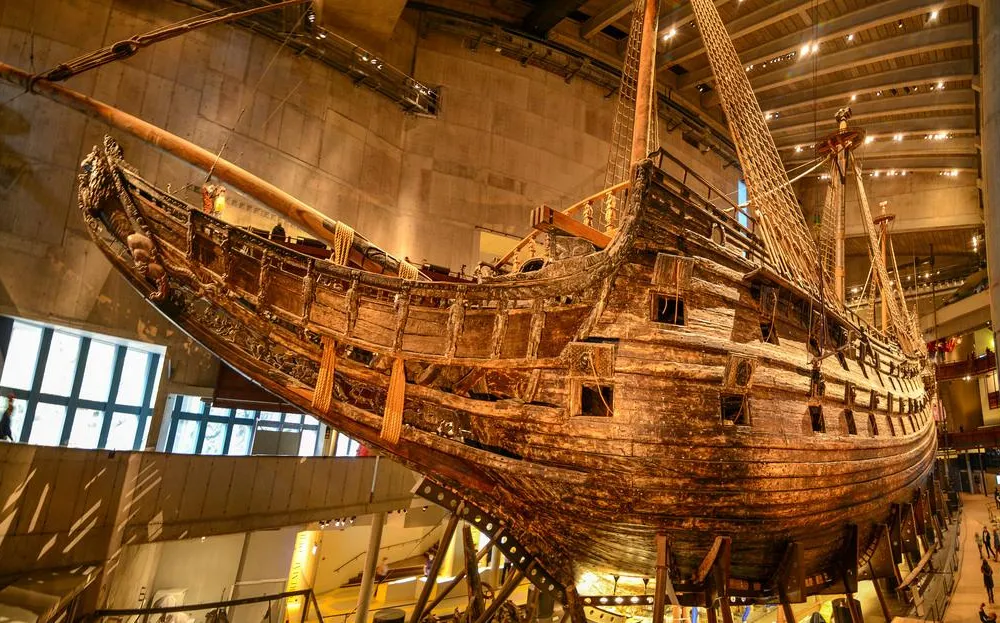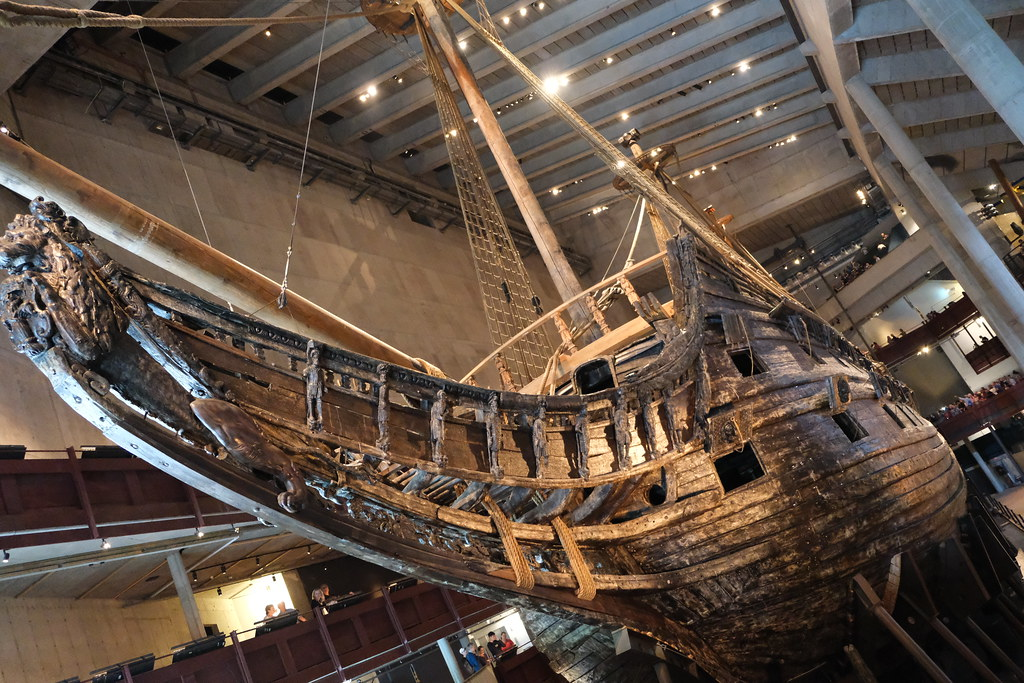Introduction
In the annals of maritime history, few tales capture the imagination quite like the story of the Vasa, a majestic Swedish warship that met a tragic fate on its maiden voyage in 1628. This heavily armed vessel, brimming with 64 bronze cannons, sank less than a mile into its journey, its top-heavy structure and insufficient ballast proving to be its undoing.

Yet, the Vasa’s demise was not the end of its remarkable story. After spending 333 years resting on the seafloor of the Baltic Sea, the ship was recovered in 1961, remarkably well-preserved, and is now the crown jewel of the Vasa Museum in Stockholm. The Vasa’s recovery and ongoing conservation efforts stand as a testament to the ingenuity of marine archaeology and the crucial role played by the unique environmental conditions of the Baltic in preserving this 17th century marvel.
In this blog post, we’ll delve into the captivating history of the Vasa, exploring the factors that led to its downfall, the extraordinary efforts behind its recovery, and the lasting legacy it has left on our understanding of 17th century shipbuilding and maritime archaeology.
The Rise and Fall of the Vasa
The Vasa was commissioned by the Swedish King Gustavus Adolphus in the early 1620s, as part of his ambitious plan to transform Sweden into a major naval power. The ship was designed to be a formidable warship, capable of dominating the Baltic Sea with its impressive armament of 64 bronze cannons.
Construction on the Vasa began in 1626 under the supervision of shipbuilder Henrik Hybertsson. From the outset, the design of the Vasa was a source of controversy, with many experts expressing concerns about its top-heavy structure and the sheer weight of the cannon armament. Despite these warnings, the project forged ahead, driven by the king’s desire to showcase Sweden’s military might.

On August 10, 1628, the Vasa set sail on its maiden voyage from the Stockholm harbor, with a crew of 150 men and a complement of guests, including members of the Swedish nobility. The ship had barely traveled a mile when disaster struck. A sudden gust of wind caused the Vasa to list heavily to one side, and within minutes, the ship had capsized and sunk, taking the lives of between 30 and 50 people.
The reasons for the Vasa’s swift demise were multifaceted, but ultimately boiled down to a combination of design flaws and poor decision-making. The ship’s top-heavy structure, burdened by the weight of its extensive armament, made it inherently unstable, a problem that was exacerbated by the insufficient ballast used to counteract this imbalance.
Additionally, the Vasa’s design, which prioritized firepower over seaworthiness, was not well-suited for the conditions of the Baltic Sea. The cold, brackish waters of this region, while beneficial for the ship’s long-term preservation, presented unique challenges in terms of navigability and stability that the Vasa’s designers failed to adequately address.
The tragedy of the Vasa’s sinking was a stark reminder of the importance of striking a careful balance between a ship’s military capabilities and its ability to withstand the rigors of the open sea. The disaster not only shook the Swedish monarchy but also had far-reaching implications for the future of maritime engineering and the development of safer, more seaworthy vessel designs.
The Vasa’s Remarkable Recovery and Preservation
For over three centuries, the Vasa lay forgotten on the seafloor of the Baltic Sea, its fate seemingly sealed. However, in the mid-20th century, a team of Swedish archaeologists and marine salvage experts set out to uncover the secrets of this lost vessel.
The recovery of the Vasa was a monumental undertaking, requiring meticulous planning, state-of-the-art technology, and a deep understanding of the unique environmental conditions of the Baltic Sea. The cold, brackish waters of this region had played a crucial role in preserving the ship and its artifacts, creating a time capsule that offered an unparalleled glimpse into 17th century maritime history.

In 1961, after years of painstaking work, the Vasa was finally lifted from the seafloor, emerging from the depths in remarkably good condition. The ship’s wooden hull, sails, and even some of its intricate carvings had been remarkably well-preserved, thanks to the lack of shipworms and the low oxygen levels in the Baltic’s waters.
The recovery of the Vasa was a landmark achievement in the field of marine archaeology, and the ship’s subsequent preservation and display at the Vasa Museum in Stockholm have made it a global attraction, drawing millions of visitors each year.
The museum’s meticulous conservation efforts have ensured that the Vasa remains a living, breathing testament to the ingenuity and craftsmanship of 17th century Swedish shipbuilding. Through interactive exhibits, educational programs, and cutting-edge research, the Vasa Museum has become a hub for the study of maritime history, naval architecture, and the unique environmental factors that can contribute to the preservation of shipwrecks.
The Vasa’s Legacy and Lessons Learned
The story of the Vasa is not just a tale of triumph and tragedy, but a profound exploration of the complex interplay between human ambition, technological innovation, and the unforgiving forces of nature. Its legacy extends far beyond the borders of Sweden, serving as a cautionary tale for shipbuilders, engineers, and policymakers alike.
One of the primary lessons that the Vasa’s story imparts is the importance of striking a delicate balance between a ship’s military capabilities and its seaworthiness. The Vasa’s designers, in their pursuit of creating a formidable warship, overlooked the fundamental principles of naval architecture, resulting in a vessel that was top-heavy, unstable, and ultimately doomed to fail.

This tragedy has had a lasting impact on the field of maritime engineering, shaping the development of safer, more stable ship designs that prioritize both firepower and seaworthiness. The Vasa’s sinking served as a wake-up call, prompting a renewed focus on the critical role that stability, ballast, and overall structural integrity play in the success or failure of a vessel.
Beyond its influence on shipbuilding, the Vasa’s recovery and preservation have also had a profound impact on the field of marine archaeology. The remarkable condition of the ship and its artifacts, preserved by the unique environmental conditions of the Baltic Sea, has provided researchers with an unparalleled opportunity to study 17th century maritime history, from the construction techniques used in the ship’s building to the everyday lives of its crew members.
The Vasa’s story has also captivated the public imagination, becoming a symbol of the enduring power of history and the relentless pursuit of knowledge. The Vasa Museum, which houses the ship and its artifacts, has become a must-visit destination for anyone interested in maritime history, drawing millions of visitors from around the world each year.
In many ways, the Vasa’s legacy transcends the boundaries of its own time and place, serving as a powerful reminder of the fragility of human endeavors and the importance of learning from our mistakes. Its story continues to inspire and educate, reminding us that even the grandest of ambitions can be undone by the unforgiving forces of nature, and that true progress often lies in our ability to learn from the past.
Conclusion
The story of the Vasa is a captivating tale of ambition, tragedy, and triumph. From its ill-fated maiden voyage to its remarkable recovery and preservation, the Vasa has captivated the imagination of people around the world, serving as a testament to the ingenuity of marine archaeology and the enduring power of history.
As we look back on the Vasa’s legacy, we are reminded of the importance of striking a careful balance between our aspirations and the realities of the natural world. The Vasa’s sinking, a result of design flaws and poor decision-making, serves as a cautionary tale for all those who seek to push the boundaries of human achievement.
Yet, the Vasa’s story is not one of defeat, but of resilience and the relentless pursuit of knowledge. Its recovery and ongoing conservation efforts have provided us with an unparalleled window into 17th century maritime history, offering invaluable insights into the art of shipbuilding, the daily lives of sailors, and the unique environmental factors that can contribute to the preservation of shipwrecks.
As we continue to explore the depths of the world’s oceans and uncover the secrets of the past, the Vasa will undoubtedly remain a source of inspiration and a testament to the power of human ingenuity. Its legacy will continue to shape our understanding of maritime history, naval architecture, and the enduring mysteries of the sea.

